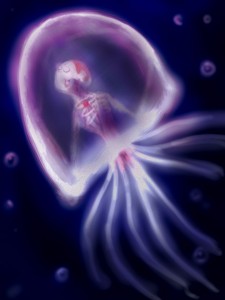This will now be a 2-part post since I recently deleted an old website of mine. I've been re-posting articles amid multiple blogs of mine lately, and have combined some posts that are related, etc.
Part 1: "Freshwater Hydra - Capable of Endless Regeneration"
The hydra's tentacles are equipped with nematocysts and/or batteries of stinging capsules with stinging threads which the hydra swiftly shoots towards any prey swimming past it. In order to move about on the object supporting it, such as a plant, it slowly glides along on its basal disc. If it's in a rush, it quickly advances via a series of somersaults. Dang, what is this, microscopic gymnastics? Ha!
The hydra can also contract completely, into a perfect round ball, at times, then resume back to its extended shape.
What does it consume? Its diet includes various insect grubs, planktonic microscopic organisms, water fleas, recently hatched tiny fry from small fishes, etc.
The victim is paralyzed by the poison from the nematocysts, allowing the hydra to push its prey into its mouth which is located at the center of its circlet tentacles.
Reproduction occurs sexually and by budding.
Hydras are well known for their ability to regenerate as they are capable of regeneration in an endless fashion, it seems. Going by what I have read in the past, their powers of regeneration surpass those of any other member of the animal kingdom. Hey, this reminds me of a blog post I wrote a while back, on another website, entitled "The Immortal Jellyfish – Turritopsis nutricula" [Link is no longer active, but it's now Part 2 of this post, down below.] - except I spoke about transdifferentiation there, instead of regeneration, but they are similar to each other, in their own special little unique way...
In 1740, the naturalist Trembley of Geneva demonstrated that a hydra cut into pieces produced as many new hydras as there were pieces; in other words, a single hydra cut into 30 fragments gave rise to 30 new hydras - all identical to the original specimen - wow!
Here's a couple images of this peculiar creature, below:
 |
---End of Part 1: "Freshwater Hydra - Capable of Endless Regeneration"
Part 2: "The Immortal Jellyfish – Turritopsis nutricula"
First of all, many of you most likely have your own opinions about mortality and immortality – whether it be basic scientific definitions of death or spiritual beliefs and whatnot. Personally, if our existence is as insane as I think it is, the textbook definition of death is far from the truth, to say the least. At any rate, that is neither here nor there at the moment, as this post is about something else entirely… or is it?
Have you ever heard of the immortal jellyfish? This small creature is scientifically labeled “Turritopsis nutricula” and it has the ability, technically, to be biologically immortal (the only known case in the world, at the moment) by way of the process known as transdifferentiation. [Side Note: This is not to be confused with the freshwater Hydra, as they are capable of endless regeneration, which is different albeit the end result is similar.]
This bizarre hydrozoan can transform from a jellyfish state that is already sexually mature, to a totally sexually immature colonial stage when it comes across unfavorable (adverse) conditions, for example. During the process of transdifferentiation, the medusa of the immortal jellyfish is transformed into the polyps that later become a new colony.
To make this easier to understand, this oceanic creature begins its life (outside of the egg stage, of course) as a little polyp until it reaches sexual maturity, in which it becomes a multi-tentacled being. From here, it has the capability to amazingly transform back to the polyp stage after it reabsorbs (resorbs) its tentacles, mesoglea, etc.
This whole transdifferentiation thing is worth further study. I suppose the confined and/or limited forms of transdifferentiation would be like a salamander’s ability to regrow limbs, and many of us have seen the lizards that regrow their tails, etc. However, the Immortal Jellyfish can regenerate everything!
Of course, the aquatic Turritopsis nutricula is only biologically immortal in theory, as we all know that this thing will become another creature’s snack via the food chain or die from disease at some point in time, but theoretically this freaky medusa has the ability, in a perfect world, to live forever.
So, what does this mean for us? Well, research for one along with the hopes that this can somehow help the scientific community learn more about transdifferentiation and hopefully find a way to make stem cells use this regenerative process for renewing damaged or dead tissue in humans. The human body is generally very resilient when healthy, but having the knowledge, know-how and ability to renew dead or damaged cells by learning more about the cellular processes behind the Turritopsis nutricula, makes the Immortal Jellyfish that much more important.
Side Note: The last I heard, the population of these strange little jellyfishes are on the rise, so we shouldn’t have to worry about having trouble finding the specimens to research anytime soon, unless something globally really goes awry in the future (yikes!). Anyway, I just thought I’d share a few interesting tidbits today – brought to you by Mother Nature; cheers!
Check out this cool image below, which is what I’d call the depiction of jellyfish immortality:
—End of Part 2 "The Immortal Jellyfish – Turritopsis nutricula"
Image Credits: perpendicularity.org/blog/ [Link is no longer active]
---End of Post "Immortal Jellyfish & Freshwater Hydra - Capable of Endless Regeneration"



No comments:
Post a Comment